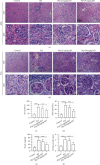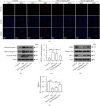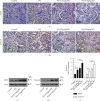Isorhapontigenin Modulates SOX9/TOLLIP Expression to Attenuate Cell Apoptosis and Oxidative Stress in Paraquat-Induced Acute Kidney Injury
- PMID: 35720190
- PMCID: PMC9203234
- DOI: 10.1155/2022/3328623
Isorhapontigenin Modulates SOX9/TOLLIP Expression to Attenuate Cell Apoptosis and Oxidative Stress in Paraquat-Induced Acute Kidney Injury
Abstract
Paraquat (PQ) is a widely used herbicide but can be lethal to humans. The kidney is vital for PQ elimination; therefore, explorations for therapeutic approaches for PQ-induced acute kidney injury (AKI) are of great significance. Here, the effects of a natural bioactive polyphenol isorhapontigenin (ISO) on PQ-AKI were investigated. In vitro experiments carried out in PQ-intoxicated rat renal tubular epithelial cells (NRK-52E) showed that ISO treatment inhibited PQ-induced cell apoptosis and oxidative stress, which was evidenced by the decreased proapoptotic proteins [cleaved caspase 3/9 and poly (ADP-ribose) polymerase (PARP)], the reduced oxidative stress indicators [reactive oxygen species (ROS), malondialdehyde (MDA), and lactate dehydrogenase (LDH) leakage], and the increased antioxidants [superoxide dismutase (SOD), nuclear factor E2-related factor 2 (NRF2), and oxygenase-1 (HO-1)]. Furthermore, 50 mg/kg ISO pretreatment before PQ administration significantly attenuated PQ-AKI in rats, as manifested by the improved renal tubule damage, the reduced serum and urine markers of kidney injury, and the inhibited cell apoptosis and oxidative stress in the renal cortex. Furthermore, expression of sex-determining region Y box 9 (SOX9) and Toll-interacting protein (TOLLIP) in NRK-52E cells and the renal cortex was significantly upregulated after ISO treatment. Overexpression of SOX9 increased TOLLIP transcription and attenuated PQ-induced apoptosis and oxidative stress, whereas knockdown of SOX9 impaired the protective effects of ISO on NRK-52E cells against PQ toxicity. In conclusion, the present study demonstrated that ISO modulated SOX9/TOLLIP expression to attenuate cell apoptosis and oxidative stress in PQ-AKI, suggesting the potential of ISO in treating PQ-poisoned patients.
Copyright © 2022 Qiang Zheng et al.
Conflict of interest statement
The authors declare no conflict of interest.
Figures







Similar articles
-
Isorhynchophylline ameliorates paraquat-induced acute kidney injury by attenuating oxidative stress and mitochondrial damage via regulating toll-interacting expression.Toxicol Appl Pharmacol. 2021 Jun 1;420:115521. doi: 10.1016/j.taap.2021.115521. Epub 2021 Apr 8. Toxicol Appl Pharmacol. 2021. PMID: 33838153
-
Overexpression of TOLLIP Protects against Acute Kidney Injury after Paraquat Intoxication through Inhibiting NLRP3 Inflammasome Activation Modulated by Toll-Like Receptor 2/4 Signaling.Mediators Inflamm. 2021 Jul 14;2021:5571272. doi: 10.1155/2021/5571272. eCollection 2021. Mediators Inflamm. 2021. PMID: 34335089 Free PMC article.
-
Protective effects of exogenous β-hydroxybutyrate on paraquat toxicity in rat kidney.Biochem Biophys Res Commun. 2014 May 16;447(4):666-71. doi: 10.1016/j.bbrc.2014.04.074. Epub 2014 Apr 19. Biochem Biophys Res Commun. 2014. PMID: 24755084
-
Protective effect of toll-interacting protein overexpression against paraquat-induced lung injury in mice and A549 cells through inhibiting oxidative stress, inflammation, and NF-κB signaling pathway.Respir Physiol Neurobiol. 2021 Apr;286:103600. doi: 10.1016/j.resp.2020.103600. Epub 2020 Dec 14. Respir Physiol Neurobiol. 2021. PMID: 33333238
-
Protective effects of natural compounds against paraquat-induced pulmonary toxicity: the role of the Nrf2/ARE signaling pathway.Int J Environ Health Res. 2024 Jan;34(1):611-624. doi: 10.1080/09603123.2022.2163985. Epub 2023 Jan 22. Int J Environ Health Res. 2024. PMID: 36682065 Review.
Cited by
-
Molecular Mechanisms of Oxidative Stress in Acute Kidney Injury: Targeting the Loci by Resveratrol.Int J Mol Sci. 2023 Dec 19;25(1):3. doi: 10.3390/ijms25010003. Int J Mol Sci. 2023. PMID: 38203174 Free PMC article. Review.
-
Paraquat disrupts the blood-brain barrier by increasing IL-6 expression and oxidative stress through the activation of PI3K/AKT signaling pathway.Open Med (Wars). 2024 Sep 11;19(1):20241020. doi: 10.1515/med-2024-1020. eCollection 2024. Open Med (Wars). 2024. PMID: 39291284 Free PMC article.
-
Traditional Chinese Medicine and renal regeneration: experimental evidence and future perspectives.Chin Med. 2024 Jun 3;19(1):77. doi: 10.1186/s13020-024-00935-9. Chin Med. 2024. PMID: 38831435 Free PMC article. Review.
-
Isorhapontigenin: exploring a promising resveratrol analog for disease management through diverse signaling pathways-a review with computational insights.Naunyn Schmiedebergs Arch Pharmacol. 2025 Apr 17. doi: 10.1007/s00210-025-04176-x. Online ahead of print. Naunyn Schmiedebergs Arch Pharmacol. 2025. PMID: 40244453 Review.
-
Frontier role of extracellular vesicles in kidney disease.J Nanobiotechnology. 2024 Sep 20;22(1):583. doi: 10.1186/s12951-024-02852-3. J Nanobiotechnology. 2024. PMID: 39304945 Free PMC article. Review.
References
MeSH terms
Substances
LinkOut - more resources
Full Text Sources
Research Materials

